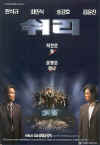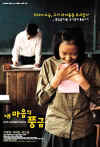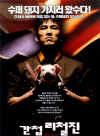1999
The Best Selling Films of 1999 (through January 26)
Domestic Films Tickets Release Weeks 1. "Shiri" 2,440,000 Feb 13 17 2. "Attack on the Gas Station" 962,000 Oct 2 11 3. "Tell Me Something" 740,000 Nov 13 6 4. "Nowhere to Hide" 672,500 Jul 31 9 5. "Happy End" 563,000 Dec 11 6 6. "Yonggary" 500,000 Jul 17 6 7. "Ghost in Love" 420,000 Aug 14 5 8. "Phantom the Submarine" 365,000 Jul 31 7 9. "The Ring Virus" 340,000 Jun 12 7 10. "City of the Rising Sun" 332,000 Jan 1 5 |
Overall Figures Tickets Release Weeks 1. "Shiri" (Korea) 2,440,000 Feb 13 17 2. "The Mummy" (U.S.) 1,260,000 Jul 10 8 3. "Attack on Gas Station" (Korea) 962,000 Oct 2 11 4. "The Matrix" (U.S.) 910,000 May 15 9 5. "Sixth Sense" (U.S.) 879,000 Sep 18 9 6. "Tarzan" (U.S.) 820,000 Jul 17 7 7. "Star Wars: Episode One" (U.S.) 811,000 Jun 26 7 8. "Tell Me Something" (Korea) 740,000 Nov 13 6 9. "Toy Story 2" (U.S.) 694,000 Dec 18 6* 10. "Love Letter" (Japan) 692,000 Nov 20 8 |
|
Films in Korea are universally priced at 6000
won (~$5.00). The figures above represent the total number of tickets
sold for each film in Seoul only. An asterisk indicates that the film is
still playing in theaters. |
Director, Kang Jae-gyu Actor Han Suk-kyu, Choi Min-shik, Song Kang-ho
Shiri (pronounced "Shee-ree", alternate spelling: "Swiri") has drawn praise from a wide variety of sources. Members of the Korean national intelligence agency gave it a standing ovation for its detailed and accurate depiction of espionage operations. It has already received honors for best picture and best actor Choi Min-shik, for his portrayal of a North Korean agent) at domestic awards ceremonies. The making of the film has even been analyzed and offered up as a model for Korean businesses hoping to succeed in the new century.
Director Lee Young-jae Actors Lee Byung-heon, Jeon Do-yeon
The setting for this film is 1962, when a young teacher from Seoul takes his first job at a village school in Kangwon Province. At this time one of his older students begins to fall in love with him. She makes use of her daily journal assignments to comment on his teaching and ask him probing, curious questions. When she notices a romance developing between him and another teacher, she does her best to discredit her rival by harping on her age and stealing her shoes in class.
Director and screenwriter Jang Jin
Late at night, a North Korean spy washes onto the shores of Kangwon Province unseen and prepares for his initial assignment: to find and steal the genetically-engineered "Superpig", an animal developed by a team of South Korean biologists. Within hours, however, he falls victim to a group of thieves who steal his belongings and leave him stranded. As time goes on he realizes that his training did nothing to prepare him for the complex life he leads in the South.
Director Kim Dong-bin
With the help of a beleaguered neurologist who performed autopsies on the victims and pronounced their deaths to be supernatural, Sun-ju learns that the videotape was made by a psychic named Un-seo who had years earlier been thrown into a well. Sun-ju now stakes her survival on somehow contacting this young woman from the past.
Director Lee Myung-sae
There are several types of movement which propel this film: the physical movement of the actors (Lee reportedly spent time analyzing the movement in dance and World Cup soccer); the visual movement created by lines of composition within the frame; movement through time (the time for each major scene is faithfully printed for the viewer); movement towards resolution of the plot (a cat-and-mouse chase between a group of cops and a killer); and the movement inherent in Lee's editing, which removes small chunks of the original footage to create a muted, staccato-like propulsion (he makes frequent use of what I guess you would call a "jump-dissolve"). But in contrast to the scattered movement you see in a film such as Wong Kar-Wai's Chungking Express, the movement in this film is directed inward, as it guides us relentlessly to the final confrontation between the pursuer and the pursued.
Director Kim Sang-jin
Four young thugs are bored one night, so they decide to rob a gas station, just for fun. When they find it has no money, however, they lock the employees up and stay there for the night, pumping gas. Once they get the hang of the equipment, the money starts to flow, and if customers give them any problems, they just take them hostage.











